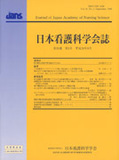Japanese
English
- 販売していません
- Abstract 文献概要
- 参考文献 Reference
- サイト内被引用 Cited by
要旨
目的:がんとがん以外の在宅高齢者の終末期ケアにおける経過時期別の緊急ニーズについて,両群の類似点と相違点および特徴を明らかにする.
方法:2003年,2004年に在宅死した高齢患者のがん事例(A群)112名,がん以外の事例(B群)119名に対して訪問看護ステーションにおける緊急電話と緊急訪問の回数とニーズについて,在宅終末期ケアの「開始期」,「小康期」,「臨死期」の経過時期別(期間ごと)に調査した.
結果:対象者の年齢は,A群79歳(SD 8.4),B群86.6歳(SD 7.9)で,在宅ケア期間は,A群が34日,B群が185日であった.A群一人当たりの緊急電話は3.3回,緊急訪問は2.2回,B群の一人当たりの緊急電話は3.5回,緊急訪問は2.7回であった.ケアニーズは,両群ともに「症状の変化」と「身体的ケア」が全期間を通じて高く,A群は,「疼痛コントロール」,B群では「介護技術」が高いニーズであった.
結論:在宅高齢者の終末期ケアにおいては,これら経過時期別の緊急ニーズに対応したケアとその予防およびケア体制が必要と考えられた.
Abstract
Purpose:This study aimed to investigate emergency care needs of terminally elderly in home care.
Method:The subjects were terminally elderly who died in the 2003 and 2004 calendar years. We divided elderly into two groups, elderly with cancer (Group A, 112) and elderly with diseases other than cancer (Group B, 119), and investigated the reason for each emergency call and emergency visit by a visiting nurse, analyzing interventions according to the terminal home care stage (Introductory, Stability, and Near-death phases) and service needs involved.
Result:The average age at death and duration of care were 79 years (SD 8.4) and 34 days in Group A, 86.6 years (SD 7.9) and 185 days in Group B. Emergency calls and visits were made 3.3 times and 2.2 times per elderly in Group A and 3.5 times and 2.7 times in Group B. In both A and B Groups, adverse changes in elderly's physical symptoms were the most frequent reason for these interventions and the family's psychological care was consistently needed throughout the care process. Distinctive needs were found for pain control in Group A and for care techniques by family in Group B.
Conclusion:From the above, the care, prevention and care system for emergency needs by stages are considered to be required in terminal care of the home-care elderly.
Copyright © 2008, Japan Academy of Nursing Science. All rights reserved.


